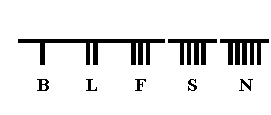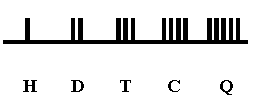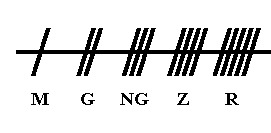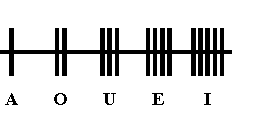 Brave
Lad
Fear
Surely
Not Brave
Lad
Fear
Surely
Not
 Hidden
Death
Time
Conquers
Questions Hidden
Death
Time
Conquers
Questions
 Money
Gains
Knowledge
Justice
Reigns Money
Gains
Knowledge
Justice
Reigns
 Apollo
Our
Ultimate
Eloquent
Illusion Apollo
Our
Ultimate
Eloquent
Illusion
Thought to have
been invented c.1700 BCE, in or near Sinai, the
acrophonic alphabet became codified (or
ordered) at some point before its
adaptation as a cuneiform script at Ugarit,
1400 through 1200 BCE. The
letter-order remained little changed as
the alphabet was later used by the
post-Ugarit Canaanite Phoenicians, followed
by the Hebrews, Greeks,
Etruscans, Romans, Arabs, and on out across
the world. Though the alphabet
diffused to far away places, in many cases
some semblance of the original
letter-order may still be found, and it's
not difficult to trace the development of
individual letter-forms (e.g., from South
Semitic and Aramaic to Bramhi and
Kharoshti, to Malay scripts and their
influence on the problematic Philippine
alphabet). The letter-order of the
alphabet has had amazing staying power,
with the notable exceptions of two early
European scripts: Norse runes and
Irish ogham. Runes have a different
letter-order, but their physical shapes
show a clear relationship to Etruscan,
which prompts a date of invention
c.300-200 BCE. Ogham, however, consists
of straight lines usually carved
into wood or stone, defies a ready relationship
with another alphabet, and
continues to provoke investigators.
How like the Irish!
Accepted theories
and models are sometimes challenged when new
discoveries necessitate revision, but
ancient anomalies, curiosities, enigmas, or
the little understood (like the Irish
ogham script, for example), always seem at
risk of being regarded with extreme opinions.
Ogham, often associated with
the mysterious Celtic-priests, the Druids,
continues to be vulnerable to the
wildest of claims, both from zealous amateurs
and cautious professionals.
Well, amateurs and professionals alike
have described ...interesting origins to
ogham, and a few of them are worth mentioning.
At the beginning
of this century R. A. S. Macalister promoted the
hypothesis of a Western Greek (Chalcidian)
influence on ogham, an avenue
many scholars still stroll down to this
day. Macalister also regarded ogham as
a secret finger-alphabet used by the Druids.
No firm date of invention was
ever advanced by Macalister, though with
Caesar's mention that the Druids
were forbidden to use writing, the hypothesis
allowed for invention before the
first century BCE, perhaps a few to several
centuries before. This approach,
while honest and sound, is now considered
somewhat hindered by the previous
association of Druids and such European
megalithic structures as Stonehenge,
which radiocarbon dating and its adjutant
technology, dendrochronology, has
now shown to have been built long before
the arrival of the Celts, the Druids,
or the invention of the ogham alphabet
(or any alphabet, for that matter).
Fueled in part
by the literary and artistic 19th century "Celtic Revival," the
study of ogham became immensely popular,
and created an audience for the
publication of AURAICEPT NA N-ÉCES,
THE SCHOLAR'S PRIMER,
BEING THE TEXTS OF THE OGHAM TRACT
FROM THE BOOK OF
BALLYMOTE AND THE YELLOW BOOK OF
LECAN, AND THE TEXT
OF THE TREFHOCUL FROM THE BOOK OF
LEINSTER by George
Calder (Edinburgh: John Grant, 1917).
The Auraicept is a magical comedy
written and added to between c.650-1000
CE, and is thinly disguised as an
ancient learned treatise describing the
hoary antiquity of ogham. Calder's
publication of the work, with important
photographs of four folio-pages from
The Book of Ballymote showing
93 varieties of ogham, enabled later
investigators ...to have a great deal
of fun. But, here we split for the moment,
between those amateurs and professionals
who believe in a great antiquity for
ogham and those who support an invention
shortly before the composition of
The Auraicept. It
is this extreme which still makes the casual study of ogham
difficult for most (myself included).
Macalister's argument
for a Western Greek influence on the development of
ogham not withstanding (though ogham did
acquire additional characters, the
forfeda, to represent diphthongs,
based on Greek letters, and commonly
believed to have occurred quite later,
say the fifth to sixth centuries CE),
scholars soon after began to propose a
derivation from the Latin (Roman)
alphabet for the origin of ogham.
Such a derivation has steadily gained in
acceptance, but the when is still
hotly debated.
The Táin
Bó Cúainge ("The Cattle-Raid of Cooley") is an Irish
epic
commonly believed to describe Iron Age
Ireland, much like Homer's The Iliad
described Achaean-era Troy. The
Táin
has been dated to the early first century
CE, around the time of Jesus, but many
now disagree with this, some claiming
The Táin depicts
Irish life much earlier, while others maintain the Iron Age in
Ireland lasted to c.500 CE and The Táin
was probably composed shortly
thereafter. [Note: for a proposed date
of 1141 BCE, see "Eiru, Alba, and
Letha: When was a language ancestral to
Gaelic first spoken in Ireland?"
Emania 9, (1991): 17-27,
and for a late composition (though allowing for a
somewhat earlier oral-framework), see
Aspects
of The Tain, J. P. Mallory ed.,
1992, Belfast: December Publications,
pp. 151-153.] There is no mention of
writing in the works of Homer,
a fact many have pointed out tends to impart a
certain verisimilitude to Homer's "history,"
while The Táin does include a
mention of ogham. Some believe this
reference was inserted into The Táin
very late, perhaps as late as the 12th
century, and is therefor unreliable in
attempting to date the origin of ogham.
A requisite for
the study of any ancient language or script is the compilation
of a corpus ("main body") of extant examples.
This was done by Macalister in
his monumental Corpus Inscriptionum
Insularum Celticarum (1st 1945-1949,
2nd 1996, with a preface by Damian McManus,
Dublin), a work still highly
respected. The collection showed
the vast bulk of extant inscriptions occur in
Ireland, with far lesser numbers in Scotland,
Wales, England, and some of the
islands. No examples of ogham were
recorded as being from the continent,
though many amateurs and professionals
had allowed for some form of
Romano-Gaulish origin. With this
apparently solid information, many scholars
then projected a native invention of ogham
and even went so far as to declare
the script was created in the southeastern
corner of Ireland. And, as these
things go, ...it got worse.
Ebb and flow,
decadence and puritanism, liberal thinking and conservative
judgments, are the extremes we endure
until a lasting consensus is reached.
The inescapable allure of the Druids,
the Celtic myths and legends, the later
fantastic manuscript claims regarding
the age of ogham, were all too much for
academia to resist, and they've struck
back in a most surprising manner. Many
scholars today now understand ogham as
a reaction to the introduction of
Christianity. Those extant examples
referred to above? All appear datable to
after the 5-6th centuries CE. Could
ogham have arisen as a joke in the face of
Christianity? Some think so...
The Christian
Druids: On the filid or philosopher-poets of Ireland by
John
Minahane (Dublin, 1993) and Ogam
Stones and the Earliest Irish Christians by
Catherine Swift (Maynooth, 1997), are
two examples of contemporary works
which tack away from antiquity and support
a late invention of ogham, though
one does so with a smile and the other
...without smiling. There is silliness,
noble silliness, but silly stuff none
the less, contained in much speculation about
ogham. To be safe, read some of
the other extreme opinions mentioned below,
followed by both of the works above, and
then...get drunk. I did.
The current trend
to regard ogham as a druidic farce is, I believe, a
responce to previous claims, and merely
describes late changes and nuances,
but lacks the spine to understand the
necessary requirements for a script, as
opposed to some rarely used secret cipher.
I don't doubt that ogham changed
many times and eventually survived in
a Christian context. However, I have
three points of challenge to such a late,
Christian-era origin of ogham:
1) The so-called "Ballinderry
Dice," from the second century CE, which
contain an ogham for the numeral 5 represented
as three straight lines or the
ogham character "bilabial," which stands
for the letter f or v, and is used on the
dice as V, as in the Latin numerical
representation of 5. Three lines to show the
number five. The "Ballinderry Dice"
would seem to suggest ogham (as well as
an Irish familiarity with Latin) established
before the 4th century introduction
of Christianity. See: H. O'Neill
Henken, "Ballinderry Crannog No. 2,"
Proceedings of the Royal Irish Academy
47C no. 1 (1942).
2) Previous claims of no ogham on
the continent, though based on earnest and
seemingly thorough investigations, have
recently proven to be ...in error. There
is ogham on the continent.
In Brittany. Sure, just over the channel and
undoubtedly Christian, but ogham none
the less. If such ancient inscribed
monuments can evade previous searches,
may not other examples survive?
See: The Celtic Inscribed Stones Project
(CISP)
of University College
London, click here,
or for just the Breton ogham, click here.
3) Most agree that ogham originated
as a script designed for carving into
wood and was only later applied to stone.
As wood seldom survives in the
archaeological record, except under preservative
conditions, it's not surprising
we don't possess any examples. The
paucity of early runes is thus comparable
to early ogham.
While examples
of cipher scripts and occult alphabets exist, none (that I
know of) achieved the widespread usage
of runes and ogham. Usually the
invention or introduction of an alphabetic
script is an almost nationalistic affair,
with slight adaptations to individual
cultures and specific requirements to
accommodate the needs of the language
being expressed. Also, there is the
matter of the teaching of the alphabet,
a collection of letters (an abecedarium),
and a mnemonic attached to the letter-order
to facilitate learning. All such
mnemonics are lost, unfortunately, and
various reconstructions are simply
tantamount to clever guesswork.
However, it would not be unreasonable to
assume that both runes and ogham express
far different mnemonic narratives
than other alphabets.
As we await further
work and possible future discoveries, we're left with
the choices of ogham being a late creation
inspired by such Latin grammarians
as Aelius Donatus (fl. 354 CE), or being
a first century invention using the
divisions of the Latin alphabet as expressed
by the rhetorician Quintilian in his
Intitutio de Oratoria [Note:
see James Carney, "The Invention of the Ogom
Cipher," Ériu 26
(1975): 53-65.], or of having a coeval origin with runes
c.300-200 BCE. I favor this last
choice, but am unable to support the claim at
this time, except to say ...I've got a
hunch that such an early date is needed to
accommodate known developments and changes
in ogham letters and
letter-order.
Ogham, the series
of straight lines which have so troubled professionals, has
meanwhile served as a plaything for amateurs.
The well known theories of the
late Barry Fell and his claimed identification
of New World ogham, later to
include the "straight lines" from an amulet
discovered at Windmill Hill and dated
to before 2000 BCE, which Fell discerned
as alphabetic ogham (though some
centuries before the invention of the
acrophonic alphabet), has given rise to
wild descriptions of ogham being pre-alphabetic
and a global communicative
series, ...perhaps from Atlantis.
After all, so goes the argument, how else to
account for the presence of "straight
lines" in Japan, South Africa, the Near
East, and in the New World. Poor
ogham...
Straight lines
have been used since paleolithic times (see any work by
Alexander Marshack) as tallies and, indeed,
most alleged ogham in the New
World (contrary to professional claims
of being "plow marks") are numerical
counts and not a script. The ultimate
example of this would be the so-called
"Noble Twins" reading from Colorado by
Phil Leonard and the late Bill
McGlone. Leonard and McGlone discovered
a series of marks accompanied
with carvings of stars, Leonard attached
words to the marks and judged them
to be Irish and ogham, McGlone arranged
for the patina to be tested by Roger
Dorn (a pioneer in the field of dating
rock-art), and the date came back
...c.1000 BCE, far too early for ogham.
I've seen the marks and they are most
impressive and hoary with age. Unfortunately,
one can only do so much with a
series of straight lines which could ultimately
represent just about anything.
Now, there's been
fraud concerning ogham as well, notably with the alleged
ogham found in the material touted by
Zulu "witch doctor" Credo Mutwa of
South Africa (the items contain a mix
of oghamish marks, Egyptian characters,
and an unknown alphabetic script--all
items now destroyed) [Note: see Warren
Dexter, "Three Lost Collections--a Photographer's
View," The Epigraphic
Society Occasional Papers
20 (1991): 212-223.], as well as the now infamous
Burrows Cave stones, of which some examples
contain oghamish marks.
There was also some fraud some years back
involving ogham in Kentucky, but
the episode is hardly worth more than
a mention, if that.
The historian
Geoffrey Ashe described in his Land To The West: A Search
for Irish and Other Pre-Viking Discoverers
of America (1962, Viking Press)
his time in America investigating claims
of pre-Columbian contact. None of
the claims held up under scrutiny (including
the tale of St. Brendan, which
Ashe masterfully explains was written
as allegory and not dependent on any
actual "voyages" across the Atlantic by
Irish monks), except the possible
presence of ogham on the Brooklyn Bridge.
I recently spent a year and a half
in Brooklyn and, though I was oft tempted,
never went in search of the claimed
ogham. Ashe says that an Irish iron-worker
made the marks and I've no reason
to doubt him. Besides, I've personal
complaints with Brooklyn...
Ogham is not going
to go away any time soon, nor will the various theories
and models of both the amateurs and professionals.
This is as it should be.
Somewhere, perhaps not that far, there's
laughter at all this fuss over straight
lines. And, as we know, laughter
is a good thing.
bending every so slightly,
Rick
|